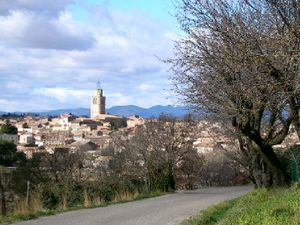Caux, Hérault
Caux ( the name comes from chaux = lime) is a circular commune with 2490 inhabitants (as of January 1, 2011 ) in the department of Hérault in the Languedoc- Roussillon region.
History
The historic market town of Caux is a jewel in the Languedoc. The name of the village, Alode de Caucio is first mentioned in a text of 961. Caux was founded as Circulade, a circular arrangement of the buildings, which allowed a defense in the turbulent history of the region on all sides. During the Hundred Years' War, Caux remained unscathed by its fortifications, but was taken in 1579 during the Wars of Religion by a trick of the besiegers. The village was burned and destroyed the castle. The reconstruction of the village lasted into the 17th century and it was now connected via a new road to the neighboring Pezenas ( seven kilometers ). Caux was electrified in 1909 and a year later the first phone came with the place. Today Caux offers its visitors a medieval church, archaeological exhibitions and all the necessary services of a modern resort. Caux is known for its excellent vineyards.
Attractions
- Menhir of Peyreficade ( = the planted stone).
- Les Capitelles, cottages, which were built of dry stones.
- Remains of limestone quarries.
- Église Saint- Gervais et Protais and their portal steeple.
Personalities
- François Bedos de Celles de Lamathe Salelles (1709-1779), called Dom Bedos de Celles, Benedictine monk, organist and organ builder.
- General Jean -Jacques Causse (1751-1796), brigadier general who served under Napoleon Bonaparte.




_mairie.JPG/270px-Caux_(Herault)_mairie.JPG)




_vue_generale.JPG/250px-Caux_(Herault)_vue_generale.JPG)